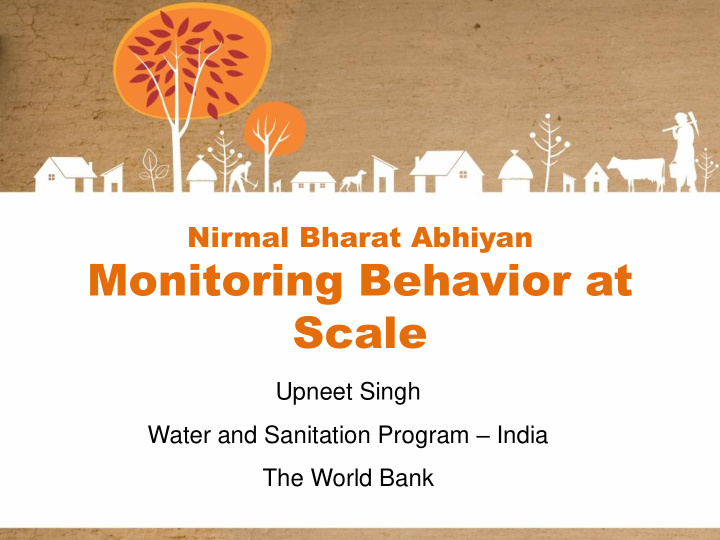



Nirmal Bharat Abhiyan Monitoring Behavior at Scale Upneet Singh Water and Sanitation Program – India The World Bank
Overview • Monitoring • Nirmal Bharat Abhiyan – Monitoring Behavior at Scale • Upneet Singh, Water and Sanitation Program-India, The World Bank • usingh@worldbank.org Summary: Unlike infrastructure, tracking behavior requires frequent cross- checks over a period of time. This has a cost in terms of time and resources. Even when large scale pen and paper surveys undertake tracking of behavior, results may be challenged on methodological grounds. Mobile to web systems offer the potential to enable tracking of outcomes in a way that is affordable, relatively quick and offers quality features such as photograph and geotag of respondents. Knowledge Sharing Forum What works at scale? Distilling critical success factors for scaling-up rural sanitation
Identifying the Goal Scaling up Rural Scaling up Sanitation Behavior Change • Sanitation = habit • Toilet construction is a means to an end • Even if few use a toilet, all are at risk, unless a community is ODF
Challenges of Monitoring Sanitation at Scale Use in decision-making and feedback to implementers 4
Current Monitoring System • Comprehensive, ICT enabled • Technically sound, works at scale • Decentralized reporting • Provides a range of reports
Potential for Strengthening • Limited indicators – Focus on financial (budget spent) and physical (toilets constructed) progress – Usage and sustainability – this needs periodic update • Time Lag – Survey/Census – significant time lag b/w data collection and results • Quality – Self reported – Lack of incentive to report quality data • Lack of Coordination – Physical and financial progress not linked – Outcomes are tracked separately from inputs/outputs
Sustainability Gap… difference between construction and usage State X Rural Sanitation Coverage Routine data (toilets constructed) vs. Household survey data 100% (usage) TSC progress 80% DLHS Forecast 60% 55% 40% 20% 14.6% 10% 9% 0% 2001 2002 2003 2004 2005 2006 2007 2008 2009 Source: TSC online reports; Census 2001; DLHS 2004; DLHS 2008 Need reliable and timely information on behavior change!
Potential to use ICT to Bridge the Sustainability Gap • Mobile usage has boomed • Mobile to web systems have potential to improve service delivery • Examples: water point mapping, motivating behavior change, complaint redressal
Tracking Behavior through Use of Mobiles 2013 2012 Testing at scale : Advocacy to scale up 1) govt 2011 system Work with Proof of MDWS and 2) third Concept in 2 NIC on party blocks 2010 design surveys Examples Flexible of Liberia modules and 13 languages Indonesia
Outcome Tracker Mobile app • # of questions – less is more! Introduction: name, informed consent, ID # Poverty Status Toilet Coverage Usage Behavior by hh member Child feces disposal Material for Hand-washing Photograph & geo-tag
Who Collects the Data 1) Govt Functionaries – Any person who is designated to train or provide handholding support to NBA implementation at village level • NBA district/block coordinators • Swachata Doot • BRC members • relevant and qualified NGOs etc – Willing participants from other departments such as Education, Health, ICDS etc. 2) Third party survey agency
How it Works
Testing at Scale Coverage and Usage data of 55,000 households in 4 months …. and counting
Advantages of Mobile Surveys • Relatively low average unit cost per record • QUICK! Real time data transfer • Electronic data entry, reduces error • Date/time stamp, helps with quality assurance • Geo-tag and photograph increases credibility
Challenges Field Supervision can reduce this
Next Steps • Potential to use for ODF verification/Baseline/Routine/NGP assessment etc – Does not require high end phones – Works in multiple languages – Module and customizable questions for Household, School, Anganwadi sanitation • Works on NIC codes, possible to integrate mobiles as an input mode to existing system
THANKS Open for Questions/Comments <usingh@worldbank.org> +91.11.41479.419
Recommend
More recommend